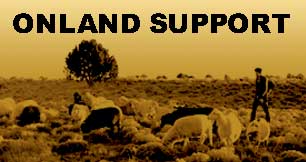Tensions run high at final Black Mesa DEIS hearing
January 16, 2007 by pathfinder
Filed under Archives
Rebecca Schubert
The Observer
FLAGSTAFF-Gathering from communities across northern Arizona and
beyond people of the many nations including the Hopi, Navajo and U.S.
came together to learn and discuss the Office of Surface Mining’s Draft
Environmental Impact Statement (DEIS). The public meeting was the
final in a series of 12 held by the U.S. Department of the Interior Office
of Surface Mining (OSM) administrators across northern Arizona.
Approximately 100 individuals were in attendance at the Little America
ballroom to share their view of the Black Mesa Draft Environmental Impact
Statement (DEIS) issued Nov. 22, 2006.
The DEIS includes the initial analysis of the potential impacts of
reopening the Mohave Generating Station in Laughlin, Nev. and returning
the Black Mesa Project to operation. Within the DEIS, which is more than
750 pages in length, OSM suggests three alternatives including:
1. Alternative A, the “Preferred Alternative”-Approval of the Life of Mine
Revision and All Associated Components of the Black Mesa Project. This
alternative would add 19,111 acres to the 44,073 existing permit area. A
coal-slurry pipeline totaling more than 273 miles would be reconstructed
inside the earth through which coal would be moved from the mine to the
generating station. To transport this coal, 6,000 acre feet of water per year
would be withdrawn from the C-Aquifer; withdrawal from the N-Aquifer
would also be permitted as necessary. In addition to this amount, 5,600
acre feet per year would be available to the Hopi and Navajo Tribes for
purchase. The proposed well field is near Leupp. These operations would
continue through 2026 with reclamation anticipated through 2038.
2. Alternative B-Conditional Approval of the Life of Mine Revision Without
Approval of the Black Mesa Mining Operations, Coal-Slurry Pipeline, and C
Aquifer Water-Supply System. This alternative would include expansion,
but omit the Black Mesa mining operation, coal-slurry pipeline preparation
plant and pipeline, coal washing system and C-aquifer water supply system.
Operations at the currently-operating Navajo Generating Station near Page
would operate through 2026 using N-aquifer water with reclamation and
public uses through 2038.
3. Alternative C-Disapproval of the Life of Mine Revision (No Action). Under
this alternative, unmined coal resource areas of the operation would not be
incorporated in the expanded permit area of the Black Mesa complex and
would not be mined. The infrastructure for the operation would be promptly
reclaimed and none of the Mohave Generating Station improvements of
Alternative A would be made. As in Alternative B, Navajo Generating Station
operations would continue through 2026, and 2038, respectively.
The meeting began with an audio-video presentation, which was to be followed
by a period of personal questions directed at OSM officials individually.
However, the crowd of people requested an open forum in which officials
would address the group at large. The speakers from the audience explained that
many of the questions were similar in nature, and to save time, it would be most
advantageous to address the crowd as a whole.
OSM officials declined the request.
“This is not a public hearing,” OSM official Rick Holbrook said. “The
purpose of this process is not to discuss the merits of this…it’s not
to discuss the political processes used.”
“I want my voice to be heard. I want my concerns to be heard orally,” said
one audience member.
A crowd of approximately 50 people jumped to their feet and began demanding
a change in the meeting’s format.
“Clearly this format isn’t working,” said Andy Bessler, the Sierra Club’s
associate regional representative of the Environmental Partnership Program.
“What’s the benefit of using this format? This format clearly doesn’t work.”
With the continued refusal, the crowd began to chant “Unfair, Unfair.”
“If you think this is unfair, then don’t be here,” Holbrook said.
Holbrook and OSM leader Dennis Winterringer backed away from the
crowd and invited them again to ask questions on an individual basis or
have their comments recorded by one of the two typists who were taking
written comments. Winterringer and Holbrook then moved to the opposite
side of the room.
“This is a direct assault on citizens here. This is a way to make a meeting
not happen,” said another crowd member.
The crowd then approached the typists and began to recite comments before
the entire audience so that everyone in attendance could hear, and so
that each comment would simultaneously be typed and become part of the
OSM record.
“I want it noted in the public record the inadequacies of this public
hearing, the fact that I want to be able to address not only OSM, but
also the Navajo Tribal officials, SRP, and I don’t know where they are
in this type of format. I have to go look at someone’s little nametag and
hunt them down to be able to get my questions answered. So this format
is not working,” Enei Begaye said.
Through these actions, it became clear that the majority of people in
attendance were in opposition to the DEIS, as well as the Preferred
Alternative.
In addition to the multiple individuals voicing opinions against the DEIS,
the public hearing schedule and the meeting format, were those unfamiliar
with the DEIS, as well as those in support of it.
Becky Daggett of Friends of Flagstaff’s Future was there to learn of the
DEIS. According to Daggett, her group has yet to discuss the impacts of the
Black Mesa mining proposals. Daggett was in attendance to understand the
issues surrounding the proposals and deliver the information to her group.
Also there as an interpreter of the events, but also in support of the
Preferred Alternative and a OSM liaison was Jerry R. Sekayumptewa, Hopi
Tribal Council Member from the village of Mishongonvi. Sekayumptewa
explained that he and his village were not affected negatively by the OSM
schedule, as they are currently in a social calendar cycle.
“I can only speak for Second Mesa,” he said. “My job is to be here, to
record what is happening and take this information back to the people.
The waythis affects people depends on the village and which cycle they
are in.”
Sekayumptewa, who is part of the Hopi Water and Energy Committee
voiced his support of the use of the C-Aquifer and N-Aquifer and the
reopening of the Mohave Generating station due to the dollars it may
bring to the Hopi nation.
“We’ve been drawn into this capitalistic society and we can’t get away from
it,” he said. Sekayumptewa said that in his younger years he most likely
would have been in opposition to the mining and water use. However, he
has come to believe that someday all the resources in the Hopi community
will be used and extinguished.
“There’s nothing I can do about it,” he said.
In contrast, former Hopi Chairman and founder of the Black Mesa Trust Vernon
Masayesva spoke vehemently against the use of the C and N Aquifers and
explained the mass opposition to the pipeline and reopening of the Mohave
Generating station in many Hopi communities.
“Tonight there are people praying in the Kivas for rain to recharge the
aquifers as they have done for generations,” Masayesva said.
The public meetings have now concluded, and Holbrook assured those in
attendance, as well as the Navajo Hopi Observer that no further meetings
would be held. Even so, individuals have until Feb. 6 to submit comments
on the DEIS to OSM.
Further information concerning the DEIS and the proposed plan can be
accessed at: http://www.wrcc.osmre.gov/WR/BlackMesaEIS.htm
Questions and comments can be directed to Dennis Winterringer, Office of
Surface Mining Reclamation and Enforcement, P.O. Box 46667, Denver, CO,
80201-6667; by phone at 303-844-1400 ext. 1440; or by email at
BMKEIS@osmre.gov
To learn more about Black Mesa Trust visit www.blackmesawatercoalition.org
or call (928) 213-9760.
Related Links:
Black Mesa Draft EIS
http://www.wrcc.osmre.gov/WR/BlackMesaEIS.htm
Black Mesa Trust
http://www.blackmesatrust.org
Black Mesa Water Coalition
http://www.blackmesawatercoalition.org
http://www.navajohopiobserver.com/main.asp?SectionID=23&SubSectionID=23&Artic
leID=5419


